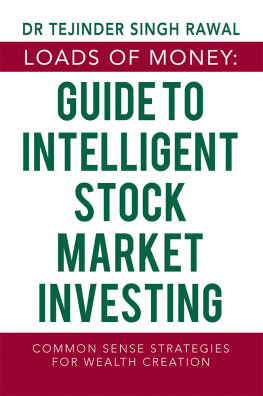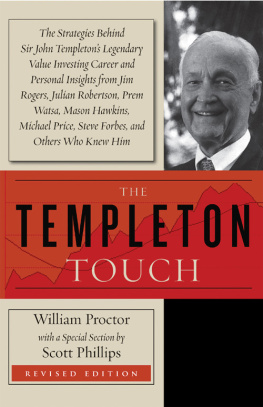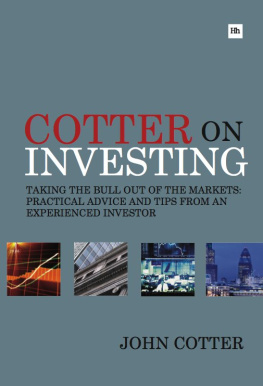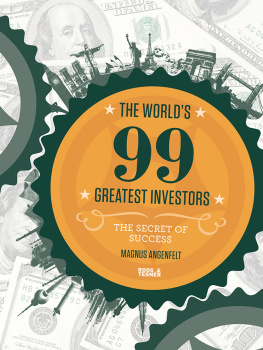Contents

Copyright 2012 by Jonathan Davis and Alasdair Nairn. All rights reserved.
Published by John Wiley & Sons, Inc., Hoboken, New Jersey.
Published simultaneously in Canada.
Letters, anecdotes, and historical information courtesy of First Trust Bank Limited as Executor to the Estate of John M. Templeton, unless stated otherwise.
No part of this publication may be reproduced, stored in a retrieval system, or transmitted in any form or by any means, electronic, mechanical, photocopying, recording, scanning, or otherwise, except as permitted under Section 107 or 108 of the 1976 United States Copyright Act, without either the prior written permission of the Publisher, or authorization through payment of the appropriate per-copy fee to the Copyright Clearance Center, Inc., 222 Rosewood Drive, Danvers, MA 01923, (978) 750-8400, fax (978) 646-8600, or on the Web at www.copyright.com . Requests to the Publisher for permission should be addressed to the Permissions Department, John Wiley & Sons, Inc., 111 River Street, Hoboken, NJ 07030, (201) 748-6011, fax (201) 748-6008, or online at www.wiley.com/go/permissions .
Limit of Liability/Disclaimer of Warranty: While the publisher and author have used their best efforts in preparing this book, they make no representations or warranties with respect to the accuracy or completeness of the contents of this book and specifically disclaim any implied warranties of merchantability or fitness for a particular purpose. No warranty may be created or extended by sales representatives or written sales materials. The advice and strategies contained herein may not be suitable for your situation. You should consult with a professional where appropriate. Neither the publisher nor author shall be liable for any loss of profit or any other commercial damages, including but not limited to special, incidental, consequential, or other damages.
For general information on our other products and services or for technical support, please contact our Customer Care Department within the United States at (800) 762-2974, outside the United States at (317) 572-3993 or fax (317) 572-4002.
Wiley also publishes its books in a variety of electronic formats. Some content that appears in print may not be available in electronic books. For more information about Wiley products, visit our web site at www.wiley.com .
Library of Congress Cataloging-in-Publication Data:
Davis, Jonathan.
Templetons way with money : strategies and philosophy of a legendary investor / Jonathan Davis, Alasdair Nairn.
p. cm.
Includes bibliographical references and index.
ISBN 978-1-118-14961-4 (hardback); 978-1-118-23921-6 (ebk); 978-1-118-22591-5 (ebk); 978-1-118-26390-7 (ebk)
1. Templeton, John, 1912-2008. 2. Capitalists and financiersUnited StatesBiography. 3. Investments. I. Nairn, Alasdair G. M. II. Title.
HG172.T45D38 2012
332.6092dc23
[B]
2011046753
To our families: Kristin, Nick, and Anna Davis and Siobhan, Hannah, Alexandra, and Lochlann Nairn With love and thanks
Introduction
Sir John Templeton was, by common repute, one of the most successful and best-known professional investors of the past 100 years, as well as an outstanding philanthropist, knighted by the queen of the United Kingdom in 1987 for his many years of charitable work. Forbes magazine dubbed him the dean of global investing, in recognition of the trail he blazed in seeking to invest across the world when others were too afraid to do so. Louis Rukeyser, host of Wall Street Week , a popular network television program, on which Templeton appeared many times, said that this quiet, deeply religious man was one of the genuine heroes of Wall Street. Prem Watsa, a Canadian fund manager, described Templeton more recently as a wonderful man and, for all practical purposes, perhaps the greatest investor of all time.
The detailed research we publish in this book confirms that John Templeton was indeed one of very few professionals who can rightly claim, hand on heart, to have consistently obtained the Holy Grail of stock market investmentabove average returns with below average risk. In his case this was a record that he sustained for the best part of half a century. His best-known mutual fund, the Templeton Growth Fund, never once in 38 years under his guidance failed to deliver a positive real (inflation-adjusted) return over any 60-month period. This is a record that only a handful of other professional investors can claim to have achieved over such a long period.
Four years after his death, Templetons name and investment philosophy live on around the world through a wide range of funds that either carry the Templeton name or claim to use his methods. Many billions of investors money is today managed on the basis of the simple but profound principles first laid down by a man who stands comparison with Warren Buffett, George Soros, Peter Lynch, and a handful of others as one of the all-time greats of the modern investment world. The reason for this enduring legacy is simple: His investment methods have stood the test of time. They work, and in this book, timed to coincide with the 100th anniversary of his birth, we set out to explain what those methods were, the truth about his track record as an investor (there are a number of surprising myths), and why and how his methods continue to be relevant today.
Given how many words have been written already on the subject, it is legitimate to inquire whether the world needs a further book on the Templeton approach to investment. We asked ourselves the same question when we originally considered embarking on this project. Amazon, the online bookseller, lists no fewer than 50 books, for example, about Templetons life, investment approach, and spiritual concerns. We came to the conclusion, however, that there is still room in the market for a single-volume, independent assessment of Templetons investment methods and philosophy, written from a professional rather than a religious, philanthropic, or family perspective; and with the future, not the past, in mind.
These are the main reasons why we believe that a single-volume study that seeks to encapsulate the essence of John Templetons investment wisdom is both fresh and timely:
1. A fresh perspective .
Some of the many books published about Templetons life and methods in the past have verged, we think it is fair to say, on hagiography. Many seem to have been written to advance his philanthropic and religious interests rather than primarily to enlighten investors. Others are either out of print, or sponsored works by close associates, published with the assistance of one of Sir Johns charitable foundations. This one, in contrast, aspires to be an independent and objective contemporary assessment by two investment professionals with many years of direct experience in the investment business. The 10 years that one of the authors (Sandy Nairn) spent working directly for Sir John have given us additional first hand insights into what his approach to investment means in practice.
2. Access to new material .
We are fortunate to have had access to a considerable amount of previously unpublished information. This includes copies of the letters that Sir John wrote to his investors and clients over the course of 50 years, as well as detailed data and analysis of his performance record that have not been professionally published before. In 1993 Mark Holowesko, then chief investment officer of Templetons fund management business, began the practice of circulating around the offices of the Franklin Templeton group copies of internal memos and letters the firms founder had written in the past. They proved popular with the firms employees and remain an invaluable source of insight into his thinking. We reproduce extracts, with our comments, in this booksome in the text, and others in the Appendix. As with the essays of Warren Buffett, the clarity and insights that characterize Templetons writings instruct as well today as they did at the date of origin.












